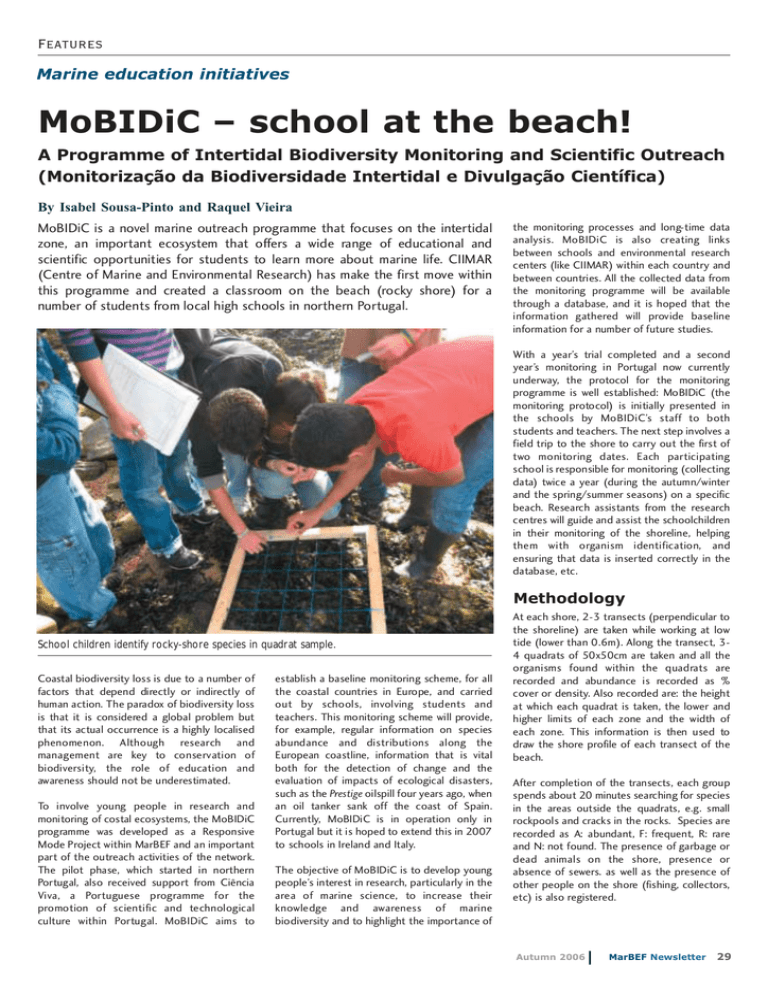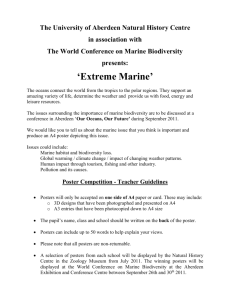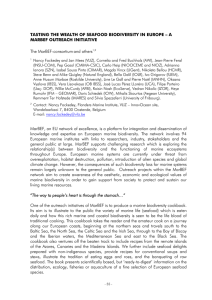Document 12307119
advertisement

Features Marine education initiatives MoBIDiC – school at the beach! A Programme of Intertidal Biodiversity Monitoring and Scientific Outreach (Monitorização da Biodiversidade Intertidal e Divulgação Científica) By Isabel Sousa-Pinto and Raquel Vieira MoBIDiC is a novel marine outreach programme that focuses on the intertidal zone, an important ecosystem that offers a wide range of educational and scientific opportunities for students to learn more about marine life. CIIMAR (Centre of Marine and Environmental Research) has make the first move within this programme and created a classroom on the beach (rocky shore) for a number of students from local high schools in northern Portugal. the monitoring processes and long-time data analysis. MoBIDiC is also creating links between schools and environmental research centers (like CIIMAR) within each country and between countries. All the collected data from the monitoring programme will be available through a database, and it is hoped that the information gathered will provide baseline information for a number of future studies. With a year’s trial completed and a second year’s monitoring in Portugal now currently underway, the protocol for the monitoring programme is well established: MoBIDiC (the monitoring protocol) is initially presented in the schools by MoBIDiC’s staff to both students and teachers. The next step involves a field trip to the shore to carry out the first of two monitoring dates. Each participating school is responsible for monitoring (collecting data) twice a year (during the autumn/winter and the spring/summer seasons) on a specific beach. Research assistants from the research centres will guide and assist the schoolchildren in their monitoring of the shoreline, helping them with organism identification, and ensuring that data is inserted correctly in the database, etc. Methodology School children identify rocky-shore species in quadrat sample. Coastal biodiversity loss is due to a number of factors that depend directly or indirectly of human action. The paradox of biodiversity loss is that it is considered a global problem but that its actual occurrence is a highly localised phenomenon. Although research and management are key to conservation of biodiversity, the role of education and awareness should not be underestimated. To involve young people in research and monitoring of costal ecosystems, the MoBIDiC programme was developed as a Responsive Mode Project within MarBEF and an important part of the outreach activities of the network. The pilot phase, which started in northern Portugal, also received support from Ciência Viva, a Portuguese programme for the promotion of scientific and technological culture within Portugal. MoBIDiC aims to establish a baseline monitoring scheme, for all the coastal countries in Europe, and carried out by schools, involving students and teachers. This monitoring scheme will provide, for example, regular information on species abundance and distributions along the European coastline, information that is vital both for the detection of change and the evaluation of impacts of ecological disasters, such as the Prestige oilspill four years ago, when an oil tanker sank off the coast of Spain. Currently, MoBIDiC is in operation only in Portugal but it is hoped to extend this in 2007 to schools in Ireland and Italy. The objective of MoBIDiC is to develop young people’s interest in research, particularly in the area of marine science, to increase their knowledge and awareness of marine biodiversity and to highlight the importance of At each shore, 2-3 transects (perpendicular to the shoreline) are taken while working at low tide (lower than 0.6m). Along the transect, 34 quadrats of 50x50cm are taken and all the organisms found within the quadrats are recorded and abundance is recorded as % cover or density. Also recorded are: the height at which each quadrat is taken, the lower and higher limits of each zone and the width of each zone. This information is then used to draw the shore profile of each transect of the beach. After completion of the transects, each group spends about 20 minutes searching for species in the areas outside the quadrats, e.g. small rockpools and cracks in the rocks. Species are recorded as A: abundant, F: frequent, R: rare and N: not found. The presence of garbage or dead animals on the shore, presence or absence of sewers. as well as the presence of other people on the shore (fishing, collectors, etc) is also registered. Autumn 2006 MarBEF Newsletter 29 Finally, all the data collected is entered into a database and analysed by the students with the help of their research assistants. This information will be available online for consultation, and we encourage schools to share their experiences of monitoring with other participants from different schools. This year, eight schools are participating in the programme, involving about 350 students, from 10 to 18 years of age, and their teachers for the monitoring of rocky beaches of the northern coast of Portugal. It is hoped that the success of the programme to date will provide a sufficient incentive for the development of the MoBIDiC programme along many other coastlines. • For more information on the MoBIDiC programme and CIIMAR, see: http://www.ciimar.up.pt/biodiversidade/index_biocost.htm http://www.ciimar.up.pt/biodiversidade/MoBiDiC/. Isabel Sousa-Pinto & Raquel Vieira Laboratory of Coastal Biodiversity CIIMAR – Centre of Marine & Environmental Research Rua dos Bragas no 289 4050-123 Porto, Portugal E-mail: ispinto@cimar.org; rvieira@ciimar.up.pt CIIMAR The Associate Laboratory CIMAR was created in March 2002 from two research centres: the Centre of Marine and Environmental Research of the University of Porto (CIIMAR) and the Centre of Marine Sciences of the University of Algarve (CCMAR). It currently includes over 450 researchers. CIMAR is dedicated to research, and to the dissemination and transfer of technology in the area of marine sciences. Its main objective is to carry out basic and applied research on the processes occurring in aquatic ecosystems, including the study of impacts of human activities on these ecosystems. The Laboratory of Coastal Biodiversity within the CIIMAR based in Porto focuses its research on taxonomy, ecology and sustainable use of seaweeds. The role of biodiversity in ecosystem functioning is also investigated in coastal ecosystems, especially in rocky shores. The laboratory participates in five projects within the MarBEF Network of Excellence, and is leading the outreach project MoBIDiC. Other research includes integrated aquaculture, where commercially important seaweeds are co-cultivated with fish to use the nutrients that are present in the water from the fish production tanks, to increase water quality and decrease the environmental impact of aquaculture. This research is done with commercial aquaculture facilities and there is a pilot plant working for the last four years. This lab has also been very active in the debate over priorities of research for the conservation and sustainable use of biodiversity, at national and European level, being a part of the European Platform for Research Strategy (EPBRS). Features Marine education initiatives Into the Deep – Irish school pupils explore the sea on board the Celtic Explorer A GMIT/Marine Institute initiative By David McGrath and Ian O’Connor Children from primary schools in the County Galway villages of Oranmore and Clarinbridge on the west coast of Ireland spent a full day on board Ireland’s largest research vessel, the 65 metre-long Celtic Explorer, in a joint initiative between the Galway-Mayo Institute of Technology (GMIT) and the Irish Marine Institute (MI). On Sunday, 19th of March 2006, the pupils mustered on a windy dockside at 06:30 in the morning, in Galway Harbour, to go to sea. The GMIT-organised trip “Into the Deep” was part of the MI’s “Explorers” programme – an integrated education project between the Marine Institute, GMIT, Galway Education Centre, Galway Atlantiquarium and other organisations in the Galway area. The programme aims to introduce young people to the potential of Ireland’s marine resource. When fully developed it will supply teacher training, educational materials and web-based facilities for those interested in the sea. 30 MarBEF Newsletter Autumn 2006 Five pupils from each of two local schools were accompanied on the vessel by teachers Mait Ó Brádaigh and Sean Holian, along with GMIT scientists and researchers Dr David McGrath, Dr Ian O’Connor, Noreen Burke, Clare Murray and Joanne O’Brien. Following breakfast on board, all passengers went on a safety tour of the vessel, being instructed in the procedures to be adopted in the case of emergency and in the use of personal protection equipment on board. The cruise carried out a basic oceanographic programme, recording the salinity, temperature, water clarity and colour at various depths in the water column at a series of ten sampling stations from Mutton Island off One of the pupils (Megan) with spider crab on board the Celtic Explorer.




